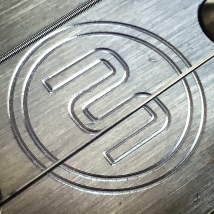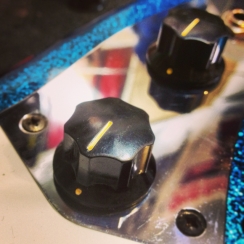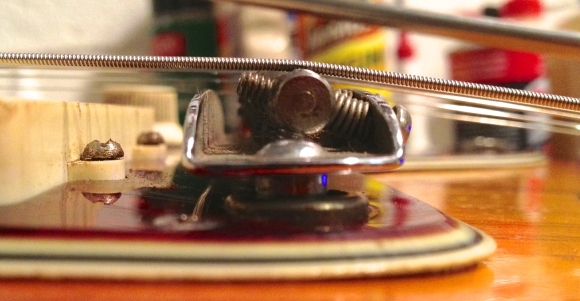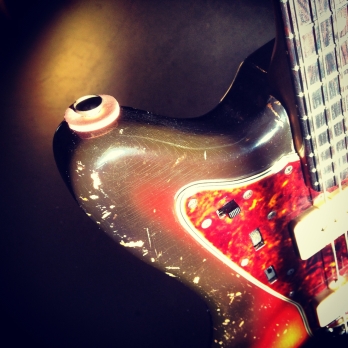 Valentines Day came and went this week, a day filled with heart emoji, chocolates and stomach-turning cuteness from couples telling the stories of how they met. Love at first sight gets a lot of play in tales of romance, but it is most definitely a thing with musicians as well. It can even lead to trouble sometimes.
Valentines Day came and went this week, a day filled with heart emoji, chocolates and stomach-turning cuteness from couples telling the stories of how they met. Love at first sight gets a lot of play in tales of romance, but it is most definitely a thing with musicians as well. It can even lead to trouble sometimes.
You’ve heard the stories of chance encounters and missed connections, I’m sure:
“I walked into the store, and there it was, just hanging on that wall. I had to make it mine.”
“Begged my friend to sell it to me for three years, and then one day he asked me if I still wanted it. I went to the bank right then and there!”
“I came back later that day with the money and it was gone! Wish I would have put it on layaway.”
For this piece, I want to tell you how Shelton Electric Instruments turned the longing gaze of this furtive lover into a two-week whirlwind romance with the GalaxyFlite model. Like the flickering light of a candle, our passion danced and then suffocated quickly, leaving behind only wisps of smoke and memories that won’t soon fade.
I Swiped Right on the Flite
 The first time I saw Shelton Breeden’s work, I was intrigued. Shelton Electric Instruments offers up instruments based on familiar shapes but with a few modern twists that set them apart from a room filled with suitors. Such twists range from back-painted pickguards and racing stripe finishes, to electronic tweaks and non-standard pickup configurations. From the photos posted on Instagram, Shelton’s manifest commitment to quality shined in a frankly oversaturated social media landscape. I was hooked.
The first time I saw Shelton Breeden’s work, I was intrigued. Shelton Electric Instruments offers up instruments based on familiar shapes but with a few modern twists that set them apart from a room filled with suitors. Such twists range from back-painted pickguards and racing stripe finishes, to electronic tweaks and non-standard pickup configurations. From the photos posted on Instagram, Shelton’s manifest commitment to quality shined in a frankly oversaturated social media landscape. I was hooked.
I skulked about on the app for some time, liking and commenting away but careful never to draw too much attention to myself. Just an admirer, this fellow. To my surprise, a direct message from Shelton soon appeared in my inbox, asking if I’d like to give some of his guitars a thorough once-over and offer some suggestions. I accepted without hesitation; any builder that wants to send me gear so I can blab about it on the internet knows how to push all of my buttons.
Red Dress and a Pearl Neck…lace

This case really gets the imagination going.
Quick to arrive at my door was this GalaxyFlite Super III model, which uses the classic offset shape as a basis for customization. Opening the very classy-looking case, that familiar candy smell of new finish rose from it and greeted me like a handshake. Immediately apparent is Shelton’s eye for detail, the nitro finish being flawless in both hue and sheen. Fiesta Red is one of those colors that just exudes cool, and Shelton certainly nailed the shade, rich and alluring as it should be. A bound-and-blocked rosewood fretboard was perfectly accessorized to the ensemble.
Speaking of visuals, let’s talk about that two-tone headstock. Some folks don’t seem to be on board with it, and I understand that it’s a deviation from the norm. Beauty is, as they say, in the eye of the beholder, yet this beholder loves it. It would seem that many builders prefer to stay in the well-tread peghead wheelhouse and only slightly tweak the shape so it’s not legally actionable. Instead, Shelton went for a design that’s half plank and half aircraft nose, evoking the image of a scimitar slicing through the air. Is it a success as unique and identifiable designs go? I’d say so. For those with less adventurous tastes, a new, sleeker version is already on its way.
 Though the neck shares the 1 11/16” nut width of Fender reissues, Shelton’s shape is slightly more substantial than what you’d find on AVRI 62 models. The more modern 9.5” radius felt as comfortable as it did familiar, so players used to flatter or rounder necks should find something to love here.
Though the neck shares the 1 11/16” nut width of Fender reissues, Shelton’s shape is slightly more substantial than what you’d find on AVRI 62 models. The more modern 9.5” radius felt as comfortable as it did familiar, so players used to flatter or rounder necks should find something to love here.
The fretwork on this Galaxy Flite is perhaps the best I’ve seen on any custom instrument, and I’m not just being kind here – this work is superior to my own. Notes ring out clear in all positions, fret ends are meticulously sculpted, and the crowns are so perfectly rounded that you barely register them whilst sliding your hand up the neck. All of this is thanks to Rachel Quinn, who handles final setup duties for the company.
I Used “Pickup Lines” in a Previous Article So I Can’t Here
 Equipped as standard are a few of my favorite brands, namely Mastery Bridge hardware, Porter pickups, and Emerson Custom electronics. Using such high-quality components means these instruments are guaranteed be fully functional and dependable right out of the box. Aside from matters of taste, there won’t be any need for round after round of upgrades here, setting Shelton apart from the few high-end builders that use cheap hardware and electronics.
Equipped as standard are a few of my favorite brands, namely Mastery Bridge hardware, Porter pickups, and Emerson Custom electronics. Using such high-quality components means these instruments are guaranteed be fully functional and dependable right out of the box. Aside from matters of taste, there won’t be any need for round after round of upgrades here, setting Shelton apart from the few high-end builders that use cheap hardware and electronics.
Three Porter Jazzmaster-style pickups occupy a swimming pool body rout, a modern-wound J-90 for the neck, a standard Jazzmaster in the middle, and a WRJM in the bridge. I really love what Porter’s doing in the pickup world, but the selection here may be the only aspect of the guitar that may need some re-thinking. On their own, each pickup sounded great and well-suited to its position, but there was a disparity in volume between them that couldn’t readily be corrected with height adjustments. Really, it came down to the J-90 being louder than the other two, so perhaps a vintage wind on that one would settle in a bit better.
Something Cliché Involving the Word ‘Curves’
The control scheme on this one could be somewhat confusing if you’re expecting the normal layout of a Jazzmaster. Instead of the lead/rhythm circuits commonly found on the guitars, Shelton opts to use the on/off switch on the upper bass side horn to split the bridge pickup and add in the middle pickup via the rollers repurposed as volumes for the neck and middle pickups. Somewhat cumbersome the first time you use it, the array becomes second nature with a little persistence – and useful as well!
Even with the learning curve, there are some potent sounds on display here. Rather than shoehorn the same old descriptors for tones, why not just listen to the thing? Click the videos below for sound samples, including one that runs through all of the available pickup selections.
Hands-On Experience
From the moment I unboxed the guitar, it played magnificently. Shipped with 10 gauge strings, the action was low and comfortable and intonation was spot-on. Clean or distorted, the guitar had much to offer in harmonic complexity, never sounding dull or flat. Again, Rachel’s expert fret and nut work played a huge part in this.
 With Mastery Bridge involved, it’s no wonder that the guitar felt solid and took all that my heavy right hand could give it. I’ve oft praised the Mastery Vibrato for finding a perfect balance of tension and smoothness, and here is no exception. With every wild stab of the arm, the guitar always returned to pitch and reacted tit-for-tat with any change in attack.
With Mastery Bridge involved, it’s no wonder that the guitar felt solid and took all that my heavy right hand could give it. I’ve oft praised the Mastery Vibrato for finding a perfect balance of tension and smoothness, and here is no exception. With every wild stab of the arm, the guitar always returned to pitch and reacted tit-for-tat with any change in attack.
At home or a loud rehearsal, this instrument covered all of my tonal needs without sacrificing the integral, forward-facing characteristics of the guitar it’s based upon. Jazzmaster fans looking for more options should find their home in the Shelton. And, if wacky features aren’t your thing, Shelton does indeed offer more simplified and classic interpretations of the offset guitar.
Love Connection
I am in no way employing hyperbole when I tell you that this may be one of the most exciting and well-built guitars I’ve ever played out of the boutique market. The quality of this instrument is just superb, and you can tell that at the end of the day Shelton Electric care about making great instruments over statements. He lets the instruments do the talking rather than making bold claims about how his work will change your life.
Modesty aside, it just very well may.























 By Michael James Adams
By Michael James Adams

